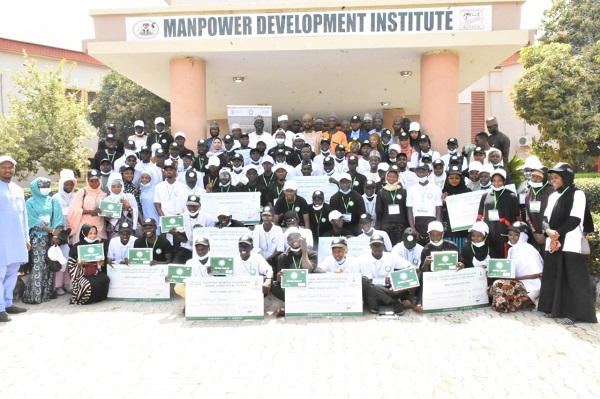
The National Information Technology Development Agency (NITDA) has announced plans to engage 5,000 students of Federal University Dutse (FUD), Jigawa, to become smart farmers in the next 10 years.
The director-general of NITDA, Mallam Kashifu Abdullahi, made this known during the closing ceremony of the National Adopted Village for Smart Agriculture (NAVSA) at the Federal University Dutse (FUD), the state capital.
Abdullahi said NAVSA was designed in line with President Muhammadu Buhari’s administration’s policies on diversification, especially on National Digital Economic Policy and Strategy (NDEPS).
“One of the critical sectors of the Nigerian economy with a high potential for economic diversification is agriculture. The sector was reported to have contributed 26.84 per cent to overall GDP in real terms in Q4 2021.
“The sector grew by 3.58 per cent (year-on-year) in the same quarter,” he said.
He noted that the average Nigerian farmer still uses primitive farm tools like hoes, cutlass among others; all of which constitute a major setback to productivity, food security and the contribution of agriculture to the economic growth of the country.
“Also, access to markets is one of the biggest challenges faced by smallholder farmers which directly affects their income and living standards.
“Lack of access to the market poses serious threats to farmers, especially their inability to sell off their produce at good prices. This leads to massive post-harvest losses and food wastage,” he stated.
The NITDA boss said NAVSA was designed to transform the sector by deploying digital technology into farming activities to attract youngsters to the farming business by using digital devices for maximum productivity and wealth creation.
“We hope to produce the next generation of agric enterprise millionaires [and] this model supports continuous adoption of the next batch and generation of FPY students.
“The continuous adoption and sustainability of the model are premised on the design of the system that ensures continuous reinvestment of the current capital and 25 per cent profit at the end of each season by each adopted farmer/student.
“In FUD, in the next10 years, over 5,000 students would have benefited, with the possibility of [creating] an additional 500, 000 direct and indirect jobs.
“This is only in FUD, NAVSA will create win-win business models for ecosystem players with far-reaching network effects to create values that never existed before across the agriculture value chain.
“In the coming years, we would start integrating emerging technologies such as remote sensing, geo-spatial analysis, artificial intelligence, big data analytics, blockchain, among others, to develop smart agriculture solutions that create new business models and opportunities across the agric value chain for the ecosystem players.
“This will, in no small measure, boost the economic diversification, growth and prosperity of the country.
“NAVSA will make it possible to precisely capture data from individual farms and fields, combine with macro-level data sets and utilise those sets in increasingly cost-effective ways. Digital data in agriculture is potentially so transformative. It offers farmers access to tailored information and insights that allow individuals to optimise their production, gain access to appropriate products and services and explore new linkages with markets.
“The use of technology to combat hunger and promote sustainable agriculture has profoundly received particular attention, perhaps more than any other development issue in the last two decades.
“Digital technologies and innovations are at the heart of managing the agriculture value chain from seedling to planting, produce monitoring to management, harvesting to processing, storage to marketing, and putting quality food on the table.
“What we have done is to rethink agriculture differently, by piloting digital technologies and innovations through a digital platform that woos and connects ecosystem players to make the journey of agribusiness seamless, productive and efficient.
“The ecosystem includes farmers, input suppliers and products’ off-takers, mobile/telecommunications service providers, banks, FinTech, smart solutions service providers, renewable energy service providers, investors, development partners, agriculture platforms, startup businesses, agriculture experts and extension workers among others,” he added.
According to him, NAVSA connects ecosystem players across the agricultural value chain to position it as a business, attract a youthful population into the agriculture enterprises and ensure there is a value addition to every farm produce for improved contribution to GDP and economic development.
“Since its launch, its implementation and sustainability models have continued to attract the attention of key players in the agricultural ecosystem, in line with global best practices.
“The untapped potentials of Nigerian farmers are currently being unfolded as the Federal Government, through the Ministry of Communications and Digital Economy, uses NAVSA Smart agriculture to change the face of the sector in the country.
“This year’s edition is presenting a green energy-powered smart brooding to improve the survival rate of broilers, a smart irrigation system to support a year-long production and a soil nutrient monitoring system to support information-driven farming on a demo land,” he explained.
The highlight of the five-day event was the inspection of smart irrigation and smart brooding system donated by NITDA’s acting director for digital economy development department, Engr. Salisu Kaka, alongside the deputy vice chancellor (academics) of the university, Prof. Abdulsalam Balarabe, as well as the presentation of NAVSA tablet devices and N100,000 Smart Farmers’ Seed Fund each to 100 beneficiaries of the Federal Government’s digital economy initiative.


